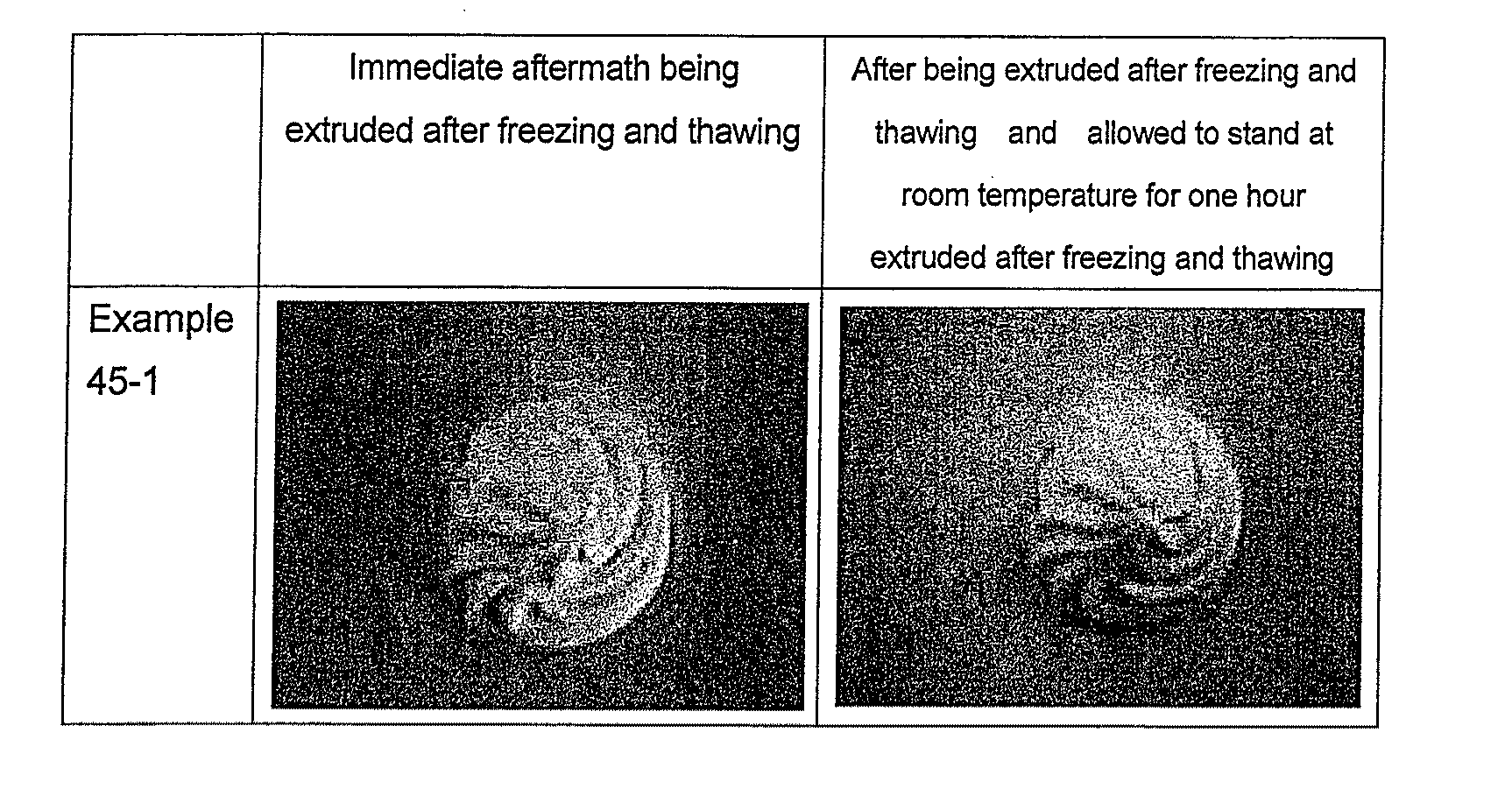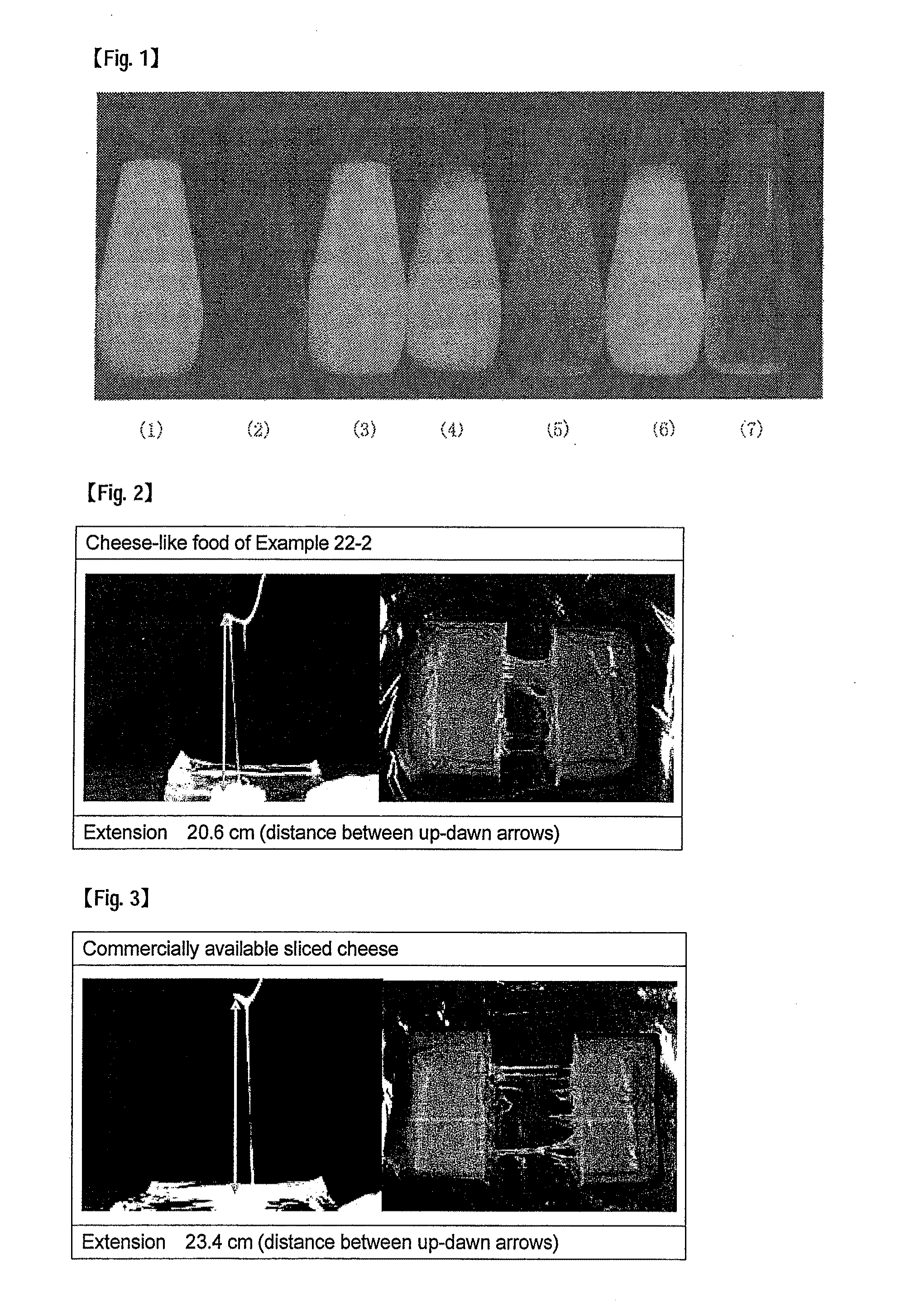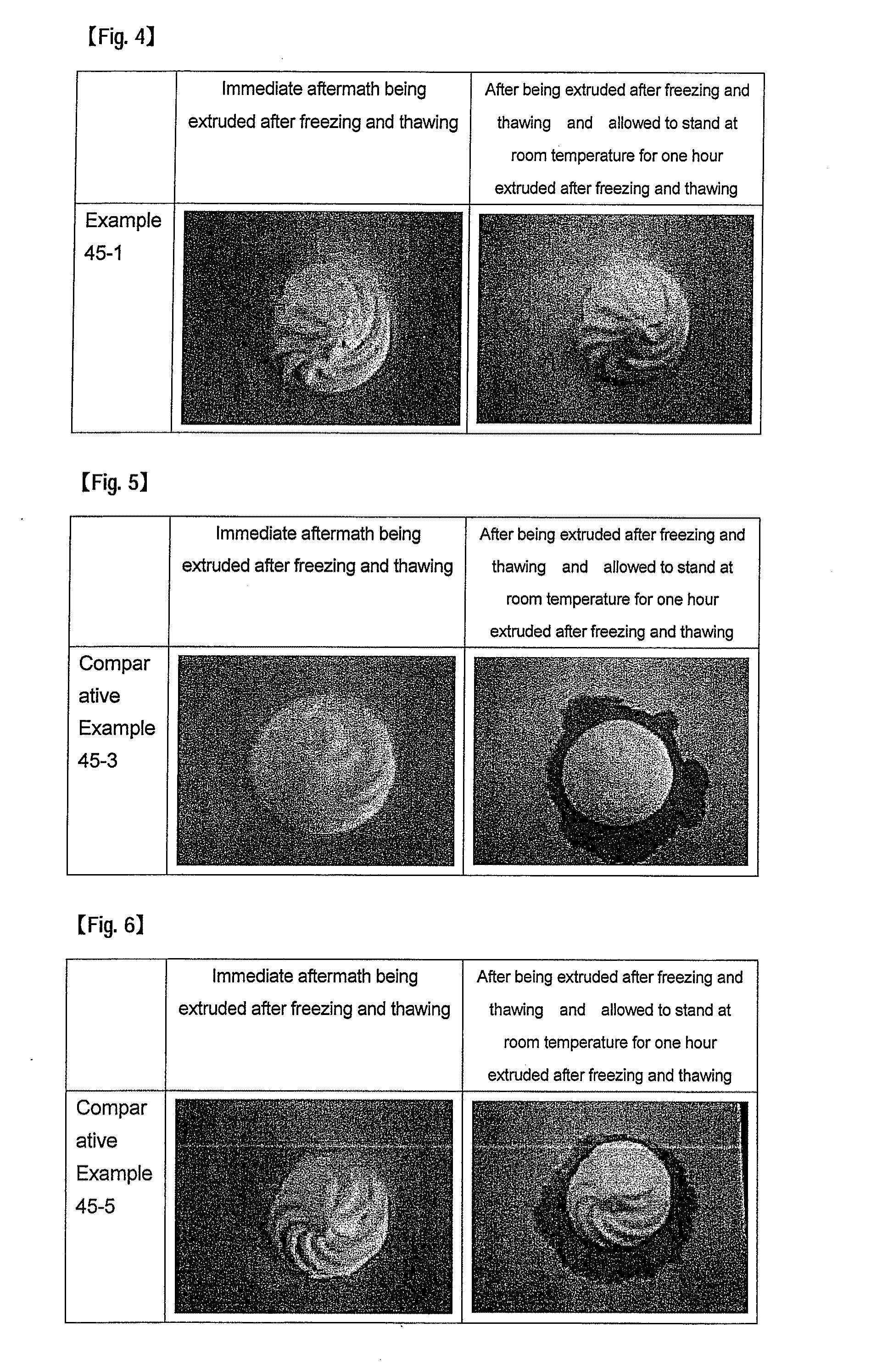When a
processed meat food is prepared using these dextrins, the
viscosity may become higher than necessary during
dissolution of the dextrins, which may make it difficult to prepare the food, or the dissolved dextrins may cause during eating of the food after being heated, resulting in lack of natural juiciness.
These emulsion foods have specific smoothness, robustness, creaminess, and glossiness, and also have a cloudy appearance.
The
starch cannot provide robustness or smoothness specific to oils and fats.
However, none of the documents describes a food product which is prepared using the dextrin or
starch and without using oils and fats and has an appearance and a
mouthfeel similar to those of emulsion foods.
A non-fat mayonnaise which is prepared using the branched dextrin described in
Patent Document 7 does not have sufficient shape retentivity or oils and fats enriched properties, and therefore, cannot mimic ordinary mayonnaise.
Also, when a low-fat mayonnaise is prepared, then if the content of oils and fats is 50 wt % or less, or is still reduced to 15 wt % or less, sufficient shape retentivity and fattiness are not obtained, so that the low-fat mayonnaise cannot mimic ordinary mayonnaise.
However, oil drops of these low-fat mayonnaise-like seasonings do not have the closest packed state, resulting in a decrease in
viscosity and therefore a liquid emulsion.
Therefore, a viscosity, a
mouthfeel and oils and fats enriched properties specific to mayonnaise cannot be obtained.
Also, an increase in the amount of a
thickening agent added so as to impart the mayonnaise-specific viscosity or
mouthfeel leads to degradation in melting in the mouth, an increase in stickiness or spinnability, and the like, i.e., a mouthfeel different from that of mayonnaise.
However, if the
starch described in
Patent Document 9 is used to try to prepare a cheese-like food, the
resultant product does not have cheese-specific shape retentivity or a cheese-specific body characteristic, and has a starch-specific sticky mouthfeel or gritty or non-smooth mouthfeel.
Therefore, a cheese-like food which is prepared using the dextrin used in
Patent Document 10 does not have good taste of fat and oil, resulting in a lack of cheese-specific robustness (body).
Therefore, when these dextrins are used to try to prepare a cheese-like food, the
resultant product is in the form of a paste and lacks the cheese-specific shape retentivity.
In addition, when a large amount of the dextrin is added so as to obtain the shape retentivity, the
resultant product has a gritty mouthfeel and lacks a cheese-like mouthfeel.
Also, when a
solid cheese is prepared, the cheese has a hard gummy mouthfeel, and its
hardness increases with time.
However, if the
milk fat content of a cheese is reduced, the cheese becomes a paste like a cheese sauce, resulting in a lack of the cheese-specific shape retentivity.
Also, a cheese-specific rich and firm mouthfeel is not obtained.
However, if the content of oils and fats derived from milk or vegetable of these desserts is reduced, a smooth mouthfeel, richness, body, and shape retentivity specific to milk fats or oils and fats are significantly reduced, the amount of released
moisture (
syneresis) is increased, and the like, i.e., the mouthfeel,
flavor and properties of the desserts are significantly affected.
However, as shown in Experimental Examples 26 to 28 described later, it was found that, when conventionally known dextrins (existing products) are used to prepare puddings, richness and oils and fats enriched properties are not obtained, and conversely, problems arose in terms of mouthfeel and
flavor of the desserts, such as powderiness, grittiness, starch
flavor and the like.
However, for yogurt, which is prepared by fermenting a
milk component, the reduction in the content of oils and fats (including oil and fat derived from milk) has a significant influence on a mouthfeel or a flavor, and therefore, yogurt-specific smoothness or richness is lost, resulting in yogurt having a watery flavor.
These steps are not present in an ordinary yogurt production process, and therefore, a complicated and
new production line (process) needs to be introduced.
Therefore, the method is not suitable for practical use.
Moreover, the techniques described in Patent Documents 15 and 16 both have a problem that the amount of
syneresis becomes more significant as the
milk fat content of yogurt is reduced.
The dextrin has a problem that powderiness or grittiness becomes more significant as the degree of debranching increases.
Therefore, even when the dextrin is used, then if the
milk fat content of yogurt is reduced, richness significantly decreases, so that a milk-specific mouthfeel or flavor cannot be obtained.
Also, the dextrin of Patent Document 19 cannot impart sufficient richness to frozen desserts.
When the content of oils and fats (including oil and fat derived from milk) of a frozen dessert is reduced, sufficient richness cannot be imparted to the frozen dessert, and in addition, the frozen dessert has powderiness, grittiness or the like.
After formation of foam,
moisture is released with time, so that the original mouthfeel of
whipped cream is lost, or the shape retentivity is lost and therefore the commodity value is lowered when it is used as a filling material.
In particular, for a
whipped cream which is distributed in a frozen state and is thawed in use,
moisture contained in the whipped cream is frozen and thawed, and therefore, fat globules formed as a part of the structure of the whipped cream are partially destroyed, so that moisture is significantly released.
In addition, moisture release (
syneresis) is likely to occur.
However, even when a
polysaccharide thickener, such as
gellan gum,
xanthan gum,
guar gum or the like, is added, various problems arise, such as an insufficient syneresis preventing effect, a heavy mouthfeel of whipped cream, occurrence of stickiness specific to
polysaccharide thickeners, poor flavor release, and the like.
There is no method capable of solving all problems, such as prevention of syneresis, maintenance of shape retentivity, and an improvement in a mouthfeel.
However, Patent Document 23 does not describe or suggest a blue value at all, and conventional dextrins do not have the effect of prevention of syneresis or an improvement in a mouthfeel in whipped creams.
However, whipped creams containing these dextrins have problems, such as occurrence of syneresis, a reduction in a mouthfeel, and the like, as shown in Experimental Example 1 described later.
Typically, these
sugar confectioneries have a soluble
solid content of as high as about 75 to 95 degrees, and therefore, even when a
polysaccharide thickener or a gelling agent which can be used in ordinary
food products is employed, the viscosity of the solution increases, resulting in difficulty in shaping or pouring.
Also, there are problems, such as that a sufficient amount of water required to dissolve a polysaccharide thickener or a gelling agent cannot be prepared, so that the polysaccharide thickener or the gelling agent is not dissolved, that reprecipitation or burning occurs during boils and fatsing down, and the like.
Therefore, there are few gelling agents applicable to sugar confectioneries.
However, for example,
gelatin has a
low melting point and is melted at about 30° C., and therefore, is softened and becomes sticky when kept at high temperature, and
gelatin-specific flavor is likely to affect the taste of sugar confectioneries.
Carrageenans are difficult to remove moisture and require a long time to boils and fats down, has a high gelation temperature and therefore has difficulty in shaping or pouring, cannot be used within an acidic range, and the like.
Agar, when its soluble
solid content is 80 or more, is insoluble and has insufficient shape retentivity, and therefore, is brittle and easy to collapse.
Moreover, as sugar confectioneries have a high soluble
solid content, if gelling agents are used in combination, the viscosity increases, leading to a deterioration in workability, or one of the gelling agents inhibits gelation of the other, for example.
Also, Patent Document 28 only discloses a dextrin which is a saccharide substitute, and does not improve the physical properties or characteristics of sugar confectioneries.
However, if the content of fats and oils, such as fats and oils derived from milk, cacao or the like, is reduced in a beverage having a considerably
high water content, oils- and fats-specific richness or body is reduced, so that the beverage has a thin mouthfeel or taste, resulting in a lack of satisfaction.
Also, when the amounts of these starch
decomposition products added are increased so as to improve the effect, starch flavor becomes significant, flavor release is worsened, or the like.
However, when polysaccharide thickeners or starches are used, viscosity is high during production, leading to a reduction in workability, and a sticky mouthfeel or a gritty mouthfeel.
Moreover, an influence of polysaccharide thickener-specific spinnability leads to a slimy (sticky) mouthfeel.
 Login to View More
Login to View More  Login to View More
Login to View More 


